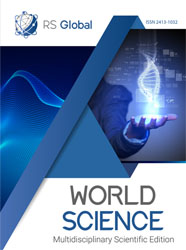О КРИТЕРИЯХ И МЕТОДИКЕ ФОРМИРОВАНИЯ ИННОВАЦИОННОЙ КУЛЬТУРЫ СТУДЕНТОВ В ПРОЦЕССЕ ИЗУЧЕНИЯ АНГЛИЙСКОГО ЯЗЫКА
Abstract
An analysis of the scientific and theoretical literature indicates that the formation of an innovative culture of students, as well as modern pedagogical technologies in the formation of cognitive activity of students, has been studied quite extensively. However, innovative approaches in the process of learning English, the application of methods and tools aimed at the formation of cognitive activity during training sessions, have not been sufficiently studied or are fragmented. Therefore, the article raises one of the urgent problems, which requires a special study.
References
Указ Президента Республики Узбекистан № УП-5847 от 20 апреля 2019 года «Об утверждении Концепции развития системы высшего образования Республики Узбекистан до 2030 года». www.lex.uz.
Бочкарева Т. С. Мультидисциплинарные дидактические комплексы как средство формирования инновационной культуры студентов вузов:дис... канд. пед. наук. – Тольятти, 2008. – 224 с.
Беспалько В. П. Слагаемые педагогической технологии. – М.:Педагогика, 1989. – 190 с.
Беспалько В. П. Стандартизация образования: основные идеи и понятия // Педагогика. – 1993. – № 5. – С. 16-25.
Галажинский Э. В. Справка. Инновационный потенциал личности: содержание, структура, пути развития // http://www.raop.ru/content/Otdelenie_psihologii_i_fiziologii.2011.06.15.Spravka.pdf (Дата обращения: 20 марта 2016 г.).
Гоулман Д., Бояцис Р., Макки Э. Эмоциональное лидерство. Искусство управления людьми на основе эмоционального интеллекта. – М.:Альпина Паблишер, 2015. – 301 с.
Делия В. П. Инновационное мышление в XXI веке. – Балашиха:Де-По. 2011. – 228 с.
Минеева, О. А., Даричева, М. В. Использование системы Moodle в процессе обучения иностранному языку студентов неязыковых специальностей.// Вектор науки Тольяттинского государственного университета. Серия: Педагогика, психология, 2015, (4(23).
Views:
306
Downloads:
261
Copyright (c) 2020 The author

This work is licensed under a Creative Commons Attribution 4.0 International License.
All articles are published in open-access and licensed under a Creative Commons Attribution 4.0 International License (CC BY 4.0). Hence, authors retain copyright to the content of the articles.
CC BY 4.0 License allows content to be copied, adapted, displayed, distributed, re-published or otherwise re-used for any purpose including for adaptation and commercial use provided the content is attributed.











